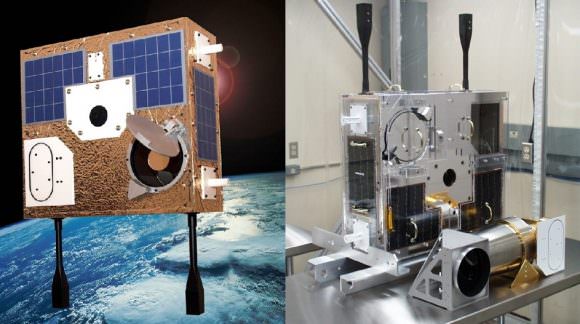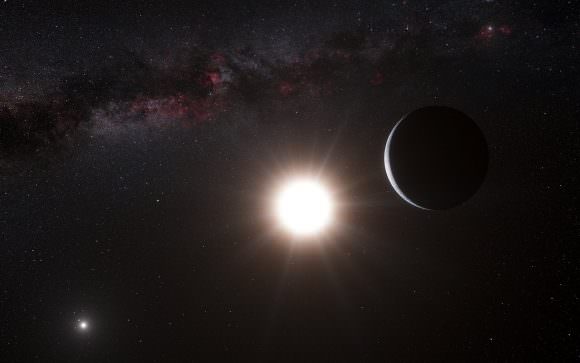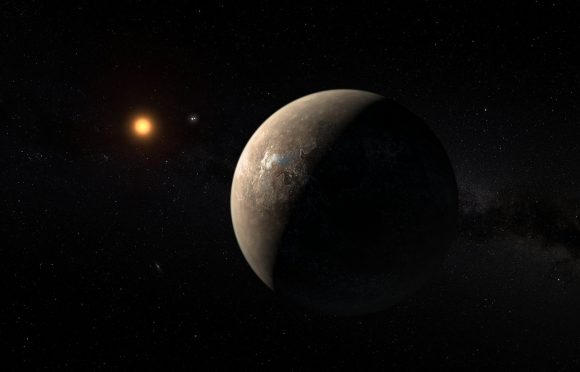Finding exoplanets is hard work. In addition to requiring seriously sophisticated instruments, it also takes teams of committed scientists; people willing to pour over volumes of data to find the evidence of distant worlds. Professor Kipping, an astronomer based at the Harvard-Smithsonian Center for Astrophysics, is one such person.
Within the astronomical community, Kipping is best known for his work with exomoons. But his research also extends to the study and characterization of exoplanets, which he pursues with his colleagues at the Cool Worlds Laboratory at Columbia University. And what has interested him most in recent years is finding exoplanets around our Sun’s closest neighbor – Proxima Centauri.
Kipping describes himself as a “modeler”, combining novel theoretical modeling with modern statistical data analysis techniques applied to observations. He is also the Principal Investigator (PI) of The Hunt for Exomoons with Kepler (HEK) project and a fellow at the Harvard College Observatory. For the past few years, he and his team have been taking the hunt for exoplanets to the local stellar neighborhood.
The inspiration for this search goes back to 2012, when Kipping was at a conference and heard the news about a series of exoplanets being discovery around Kepler 42 (aka. KOI-961). Using data from the Kepler mission, a team from the California Institute of Technology discovered three exoplanets orbiting this red dwarf star, which is located about 126 light years from Earth.
At the time, Kipping recalled how the author of the study – Professor Philip Steven Muirhead, now an associate professor at the Institute for Astrophysical Research at Boston University – commented that this star system looked a lot like our nearest red dwarf stars – Barnard’s Star and Proxima Centauri.
In addition, Kepler 42’s planets were easy to spot, given that their proximity to the star meant that they completed an orbital period in about a day. Since they pass regularly in front of their star, the odds of catching sight of them using the Transit Method were good.
As Prof. Kipping told Universe Today via email, this was the “ah-ha moment” that would inspire him to look at Proxima Centauri to see if it too had a system of planets:
“We were inspired by the discovery of planets transiting KOI-961 by Phil Muirhead and his team using the Kepler data. The star is very similar to Proxima, a late M-dwarf harboring three sub-Earth sized planets very close to the star. It made me realize that if that system was around Proxima, the transit probability would be 10% and the star’s small size would lead to quite detectable signals.”

In essence, Kipping realized that if such a planetary system also existed around Proxima Centauri, a star with similar characteristics, then they would very easy to detect. After that, he and his team began attempting to book time with a space telescope. And by 2014-15, they had been given permission to use the Canadian Space Agency’s Microvariability and Oscillation of Stars (MOST) satellite.
Roughly the same size as a suitcase, the MOST satellite weighs only 54 kg and is equipped with an ultra-high definition telescope that measures just 15 cm in diameter. It is the first Canadian scientific satellite to be placed in orbit in 33 years, and was the first space telescope to be entirely designed and built in Canada.
Despite its size, MOST is ten times more sensitive than the Hubble Space Telescope. In addition, Kipping and his team knew that a mission to look for transiting exoplanets around Proxima Centauri would be too high-risk for something like Hubble. In fact, the CSA initially rejected their applications for this same reason.
“MOST initially denied us because they wanted to look at Alpha Centauri following the announcement by Dumusque et al. of a planet there,” said Kipping. “So understandably Proxima, for which no planets were known at the time, was not as high priority as Alpha Cen. We never even tried for Hubble time, it would be a huge ask to stare HST at a single star for months on end with just a a 10% chance for success.”

By 2014 and 2015, they secured permission to use MOST and observed Proxima Centauri twice – in May of both years. From this, they acquired a month and half’s-worth of space-based photometry, which they are currently processing to look for transits. As Kipping explained, this was rather challenging, since Proxima Centauri is a very active star – subject to star flares.
“The star flares very frequently and prominently in our data,” he said. “Correcting for this effect has been one the major obstacles in our analysis. On the plus side, the rotational activity is fairly subdued. The other issue we have is that MOST orbits the Earth once every 100 minutes, so we get data gaps every time MOST goes behind the Earth.”
Their efforts to find exoplanets around Proxima Centauri are especially significant in light of the European Southern Observatory’s recent announcement about the discovery of a terrestrial exoplanet within Proxima Centauri’s habitable zone (Proxima b). But compared to the ESO’s Pale Red Dot project, Kipping and his team were relying on different methods.
As Kipping explained, this came down to the difference between the Transit Method and the Radial Velocity Method:
“Essentially, we seek planets which have the right alignment to transit (or eclipse) across the face of the star, whereas radial velocities look for the wobbling motion of a star in response to the gravitational influence of an orbiting planet. Transits are always less likely to succeed for a given star, because we require the alignment to be just right. However, the payoff is that we can learn way more about the planet, including things like it’s size, density, atmosphere and presence of moons and rings.”

In the coming months and years, Kipping and his team may be called upon to follow up on the success of the ESO’s discovery. Having detected Proxima b using the Radial Velocity method, it now lies to astronomers to confirm the existence of this planet using another detection method.
In addition, much can be learned about a planet through the Transit Method, which would be helpful considering all the things we still don’t know about Proxima b. This includes information about its atmosphere, which the Transit Method is often able to reveal through spectroscopic measurements.
Suffice it to say, Kipping and his colleagues are quite excited by the announcement of Proxima b. As he put it:
“This is perhaps the most important exoplanet discovery in the last decade. It would be bitterly disappointing if Proxima b does not transit though, a planet which is paradoxically so close yet so far in terms of our ability to learn more about it. For us, transits would not just be the icing on the cake, serving merely as a confirmation signal – rather, transits open the door to learning the intimate secrets of Proxima, changing Proxima b from a single, anonymous data point to a rich world where each month we would hear about new discoveries of her nature and character.”
This coming September, Kipping will be joining the faculty at Columbia University, where he will continue in his hunt for exoplanets. One can only hope that those he and his colleagues find are also within reach!
Further Reading: Cool Worlds

